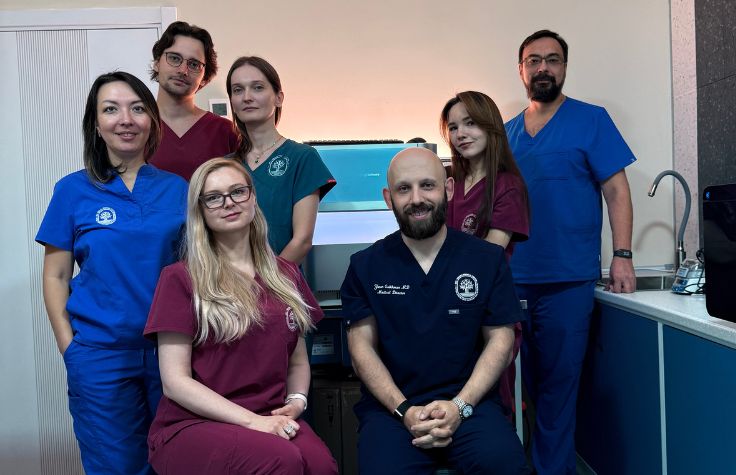
September 9, 2024
As you read this, a white box the size of a refrigerator is hurtling through space at 17,500 miles per hour (28,000 kph), shooting four lasers at the Earth 242 times a second. It’s called the Global Ecosystem Dynamics Investigation sensor, or GEDI.
GEDI laser beams travel 250 miles (400 km) down to a forest in Michigan’s Upper Peninsula and strike a precisely targeted square of trees just 98 feet (30 m) across. Some wavelengths reflect off the canopy; some penetrate to the branches below; others reach all the way to the ground before bouncing back into space.
This technology is “lidar”—like sonar but using light waves instead of sound waves. In a thousandth of a second, the beams return to GEDI, which compares how much each wavelength was absorbed to build a three-dimensional map of that square, including ground topography, foliage density, and canopy height.
GEDI is one of several instruments mounted on the International Space Station that are taking constant measurements of the world’s forests. Another, ECOSTRESS, uses infrared light to read leaf temperature. A third, DESIS, separates visible light into thousands of specific wavelengths to see exactly what color pattern the leaves are reflecting—from which you can infer details about the tree’s internal structure.
And at the University of Notre Dame Environmental Research Center in Indiana, Professor Nathan Swenson and his students are cross-referencing all this information with genetic sequencing data from trees. By correlating extremely high-resolution images taken from space with the microscopic gene expression patterns of individual leaves, they are creating a map of the forest’s health to a degree never before attempted.

A visualization of forest height data from GEDI. Image by NASA
Don’t miss the forest for the trees
How did tree ecologists and genetic researchers come to use data from space? Their partnership is quite novel, and to find out how they got there, it helps to consider how their work used to be done.
Traditionally, ecologists have assessed forest health by going into the field and measuring a few key traits in sample trees, like wood density and leaf mass per area. Doing this can tell you a bit about how the tree responds to environmental changes, but it’s time consuming and not very scalable to the forest at large. So, over the past decade, Swenson has been looking into a new method: sequencing tree transcriptomes.
While genomics chiefly studies DNA, transcriptomics studies messenger RNA molecules, which convey instructions from the DNA to other parts of the cell. An organism’s genome typically doesn’t change throughout its life—but its transcriptome represents a dynamic snapshot of all the cellular processes that are active at a particular moment, and this varies depending on the organism’s current environment.

Professor Nathan Swenson inspects a tree being sampled for his gene sequencing and remote sensing project. Photo by Barbara Johnston
Swenson ran an experiment: He subjected seedlings in a greenhouse to different drought conditions, and then performed RNA sequencing to see how their genes were responding. The results, he says, ended up more accurately predicting tree health in the wild “than anything else we typically measure in ecology. It’s kind of a quantum leap.” Later studies confirmed a pattern: The ways that trees expressed certain genes under drought accurately predicted that species’ distribution in the wild under the same conditions. “You can’t get this information by measuring something as simple as leaf thickness.”
Not too long ago, this approach wasn’t feasible. Conventional wisdom held that gene expression in the wild is too variable and sequencing it too expensive. “Through time we’ve learned that it’s totally possible,” Swenson says. “We’re now at about a third of the cost that I used to pay per sample. These things are now within reach, and scalable for the types of samples that ecologists need.”
He was onto something. By going from the bottom up—using sample transcriptomes to predict plant response in the wild—he could, as the saying goes, see the trees. But to see the whole forest, and turn those patterns into actionable data, he’d have to go from the top down...the very top.

Ecologist Vanessa Rubio measures the spectral reflectance of a red maple leaf using a field portable spectroradiometer. Photo by Barbara Johnston
How inner space met outer space
In 2019, Everett Hinkley, National Remote Sensing Program manager for the U.S. Forest Service, met with Lawrence Friedl, then-director of the Applied Sciences program at NASA. The two of them saw a need for more open conversation between NASA and the government’s land management agencies. How could their organizations work together to address each other’s research needs, share data, and promote the integration of Earth observational data products into operational land management decision support?
The answer was the Applied Earth Observations Innovation Partnership (AEOIP), which now comprises representatives from NASA, the Forest Service, the U.S. Geological Survey, and the Bureau of Land Management.
In parallel with this collaboration, NASA’s Biological Diversity and Ecological Conservation (BDEC) program began looking for opportunities to work with Illumina, since they believe that any aspect of plant health—susceptibility to disease, tolerance to climatic variation, and so on—comes down to genetic variation.
In 2023 they came upon a perfect fit for a BDEC program grant: a proposal from Nathan Swenson to monitor biodiversity by combining space station sensor readings with transcriptome sequences. AEOIP representative Sabrina Delgado Arias, an employee of Science Systems and Applications Inc. at NASA Goddard Space Flight Center, agreed that it could complement work being done by the U.S. Forest Service to map not just drought stress and wildfire risk, but the spread of invasive pests as well.
The key to linking inner space with outer space, it turns out, is leaf reflectance. The way leaves reflect light is strongly correlated with their chemical structure. So from a high enough vantage point, at a fine enough resolution, you could literally map how genetic expression for an entire forest changes over time. Swenson says, “It’s a cool science trick...if you can do it.”

The inset pictures above show where the three remote sensors are currently mounted on the space station. Photo by NASA
Taking vital signs from orbit
The three space station instruments used by the project each fill in one part of the picture. GEDI’s lidar, which reveals the forest’s structure, can show where trees might be losing branches due to sickness. ECOSTRESS’s infrared sensors take the trees’ temperature, which correlates with how much water they’re retaining and their degree of drought stress. And the color patterns detected by DESIS directly reflect the trees’ chemical structure due to transcriptomic variation.
For example: The emerald ash borer beetle lays its eggs beneath tree bark, and when they hatch, the larvae feed on the tree’s interior. It’s especially harmful in North America and Europe, where ash trees haven’t evolved natural defenses against it. The external signs of an infestation are often too subtle for the human eye—but they are revealed in leaf color pattern.

A plant's DNA usually doesn't change, but the RNA it expresses at a given time (pictured in red) varies in response to its environment and alters its chemical structure. These changes are then visible in the precise wavelengths of light the plant reflects. Illustration by Dan Letchworth
The same principle holds for oak wilt disease, a fungal infection. By the time an oak shows obvious effects, it’s too late to save it. But the shortwave infrared spectrum reflected by its leaves can show early warning signs.
This work is among the first ever taken of its kind. NASA is currently building a library of spectral characteristics for every plant species in the world, which can ultimately be compared with the recorded genomic variation of that species for even richer insights.
Jeff “Frenchy” Morisette, manager of the Human Dimensions Program at the Forest Service’s Rocky Mountain Research Station and a NASA alum himself, is optimistic about the potential applications his agency could put into practice based on this research. “Genetics is as fine a tool as we have to understand why things are happening at the structural level,” he says.

Change in a New Mexico drought from 2019 to 2020 as captured by ECOSTRESS. Data visualization by NASA
Bringing together the best technology and expertise across the sciences
The information-gathering phase of Swenson’s project is well underway. With the help of custom tools, expertise, and materials from Illumina, his team at the University of Notre Dame has transcriptomic data from leaf samples collected on site in Wisconsin and Michigan. They’re waiting their turn to download orbital imagery taken from the space station this summer, and they plan to begin building statistical models based on the data this fall.
Linking biological variables to remote sensing information massively expands the scope of their research, and everyone involved through AEOIP is buoyed by the promise it holds for changing the way ecologists work. When it comes to applying these extremely cutting-edge technologies for the sake of improving lives and livelihoods across the world, the possibilities seem endless.
“The problems of today are large scale,” Swenson says. “There are very few people working on this type of problem, and it really excited me to not stay within our silo to answer these fundamental questions, but to bring in the best technology available from multiple disciplines.” ◆

Photo by Barbara Johnston


